ISSN ONLINE(2278-8875) PRINT (2320-3765)
ISSN ONLINE(2278-8875) PRINT (2320-3765)
Lieutenant.J.Ganesan1, D. Edison Selvaraj2 and B. Selva Kumar3
|
| Related article at Pubmed, Scholar Google |
Visit for more related articles at International Journal of Advanced Research in Electrical, Electronics and Instrumentation Engineering
Three phase induction motors consume 60% of industrial electricity. Just 1% increase in efficiency of all the motors in India will save 500 MW powers which needs the initial generation cost of 2000 crores. The efficiency of an induction motor can be substantially improved by controlling the voltage to frequency ratio (V/Hz). Other methods of improving the efficiency of induction motor are 1. Coating enameled copper wire filled with several nanofillers such as Al2O3, SiO2, TiO2, CNT, ZrO2 and so on. 2. Coating of induction motor filled with nanofillers. One such method used in this project was carried out under serious literature survey. Based on the previous project works, actions were taken to use the enamel filled with SiO2 andTiO2nanofiller as the coating for the induction motor to improve its efficiency. Definitely, there will be a tremendous improvement in the efficiency of the induction motor and hence the motor can be called as “High Efficiency Induction Motor”.
Keywords |
| Induction motor, Nanocomposite, Performances analysis, Nanofillers |
INTRODUCTION |
| Induction motors are widely used in fans, centrifugal pumps, blowers, lifts, cranes, hoists and so on. The efficiency of the induction motor depends upon the insulation used. For motors, the enamel is used for three purposes: impregnation, coating and adhesion. The efficiency of the induction motor can be increased by adding the nanofillers with the enamel which is used as coating for the windings of the motor. In this paper, the efficiency of the normal three phase squirrel cage induction motor and the nanocompositeSiO2 and TiO2 in 1:3 filled enamel coated three phase squirrel cage induction motor was analyzed and the results were compared with each other. |
PREPARATION AND CHARACTERIZATION OF NANOCOMPOSITES OF SIO2 AND TIO2 |
| The micropowders of SiO2 and TiO2 were crushed into nanopowders by Ball Mill method [1] [5]. The SEM images of SiO2 and TiO2 before and after Ball Mill show the particle size of the powders. The particle size was augment by SEM images. These SEM results show that the prepared particles of SiO2 and TiO2 were in the nm range. |
| A. SEM analysis before Synthesization |
| The particle size of SiO2 and TiO2 before ball mill method was shown in figure 1 and 2. |
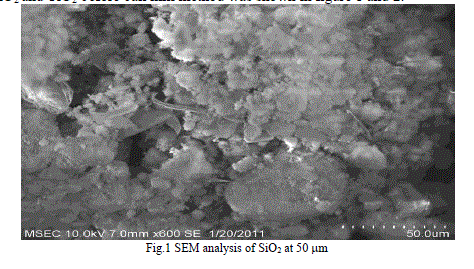 |
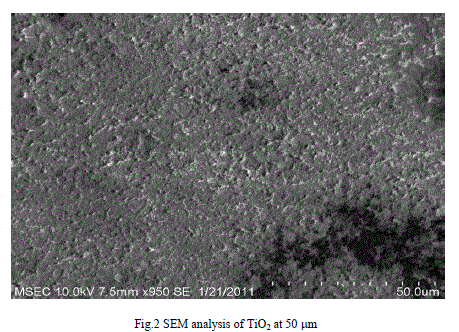 |
| B. SEM analysis After Synthesisation |
| From the analyzed SEM image the particles were in the form of nanometric range varies for one area to other. The sizes of the particles as shown in figure 3 and 4 were in the range from 40 to 100 nm size. |
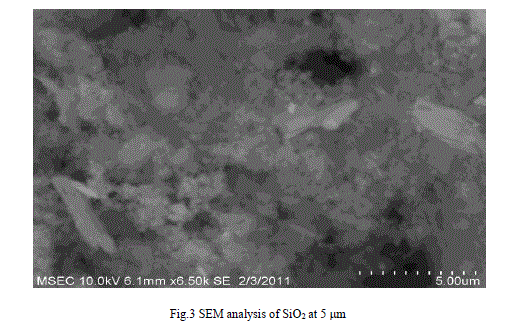 |
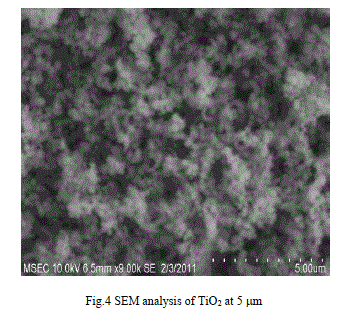 |
COATING OF THE NANOCOMPOSITE FILLED ENAMEL TO THE WINDINGS OF THE MOTOR |
| The nanopowders of SiO2 and TiO2 were taken in the proportion of 1:3. Then, the nanocomposites of SiO2 and TiO2 taken in 1:3 were mixed with the enamel by using ultrasonic vibrator. Further, this enamel was coated on the windings of the three phase squirrel cage induction motor. |
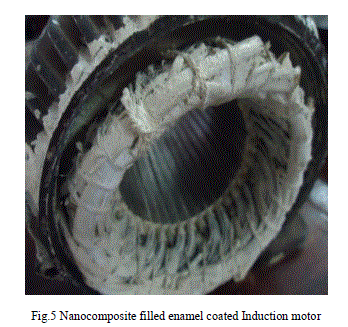 |
| The specifications of the three phase squirrel cage induction motor were shown below in the table I. |
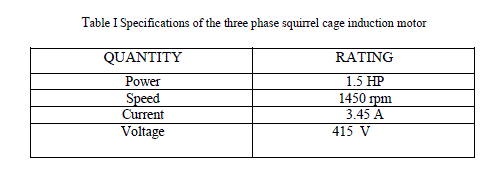 |
EXPERIMENTAL ANALYSIS |
| A. Performance Analysis of Squirrel Cage Induction Motor – Circle diagram Method |
| This analysis was done by doing open and short circuit test. By calculating the open and short circuit current and voltage the losses were found using cirvle diagram method. From the circle diagram it was found that the losses were reduced in nano coated motor. It was shown in the table II and III. |
 |
 |
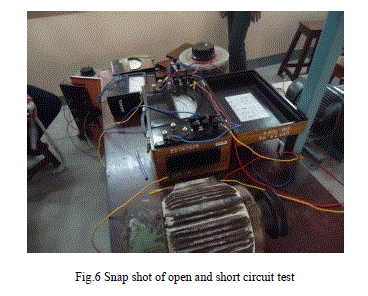 |
| Efficiency was analyzed by conducting load test in ordinary as well stator enameled with nanocomposite motor. The results obtained were successful for nanocoated motor. The efficiency of nanocoated motor increased to 4 percent. This is mainly due to reduction of dielectric losses in Nanocoated motor. The readings were calculated for various slip values and shown in table IV. |
| Table IV Efficiency comparison for ordinary and nanocoated motor |
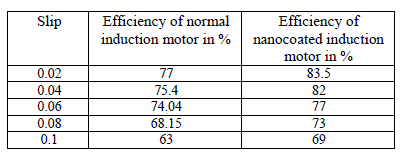 |
B. Performance Analysis of Squirrel Cage Induction Motor – Direct loading Method |
| The load test was conducted on the ordinary induction motor and the nano coated indution motor. The performance of the motor were obtained for induction motor by this method. The output power, current, efficiency, powerfactor and speed of the motor were measured during this testing. The maximum efficiency obtained from an ordinary induction motor was 78%. The maximum efficiency obtained from nano coated induction motor was 83%. |
CONCLUSION |
| The efficiency of the induction motor was increased by 5% by adding nanocomposites of SiO2 and TiO2 (1:3) to the enamel used as the coating for the windings of the three phase squirrel cage induction motor. Hence, the overall performance of the induction motor was also increased by adding nanocomposites of SiO2 and TiO2 to the enamel used in the induction motor. The speed fluctuations were also less and smooth when compared to that of the ordinary induction motor. |
ACKNOWLEDGEMENT |
| Thank God and His almighty power to finish His research work by using me, my project guide and my students for His ultimate work. |
References |
|